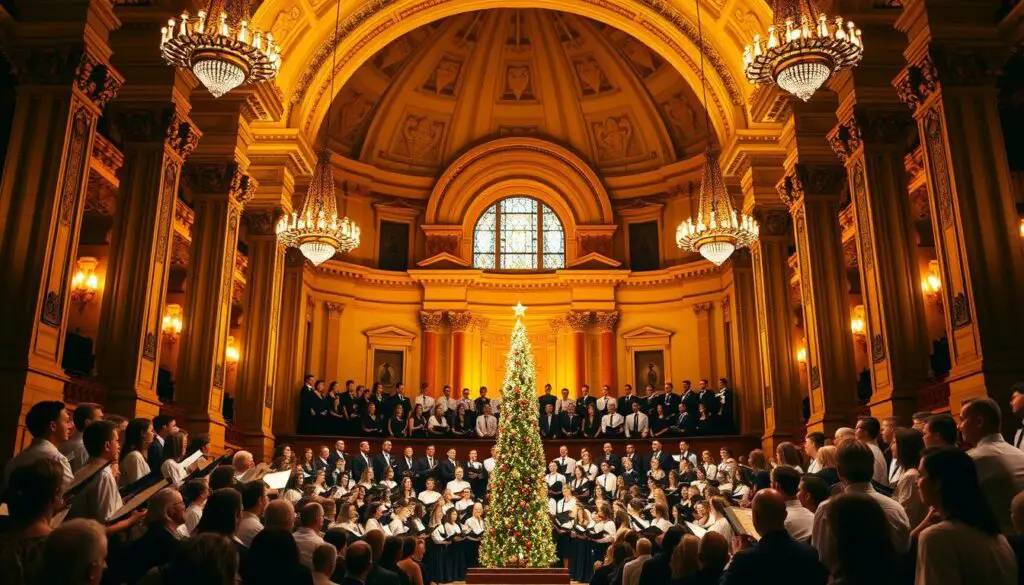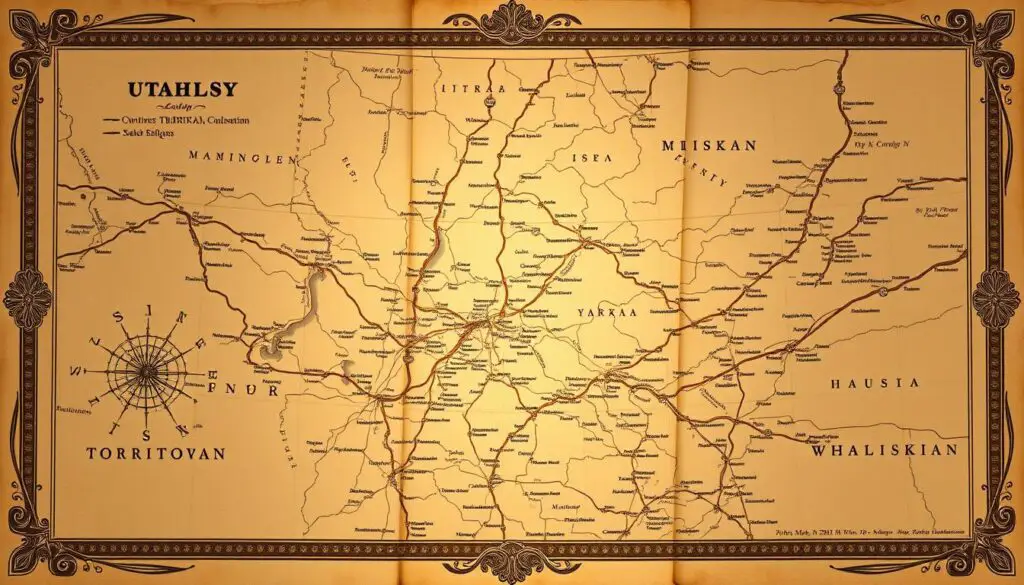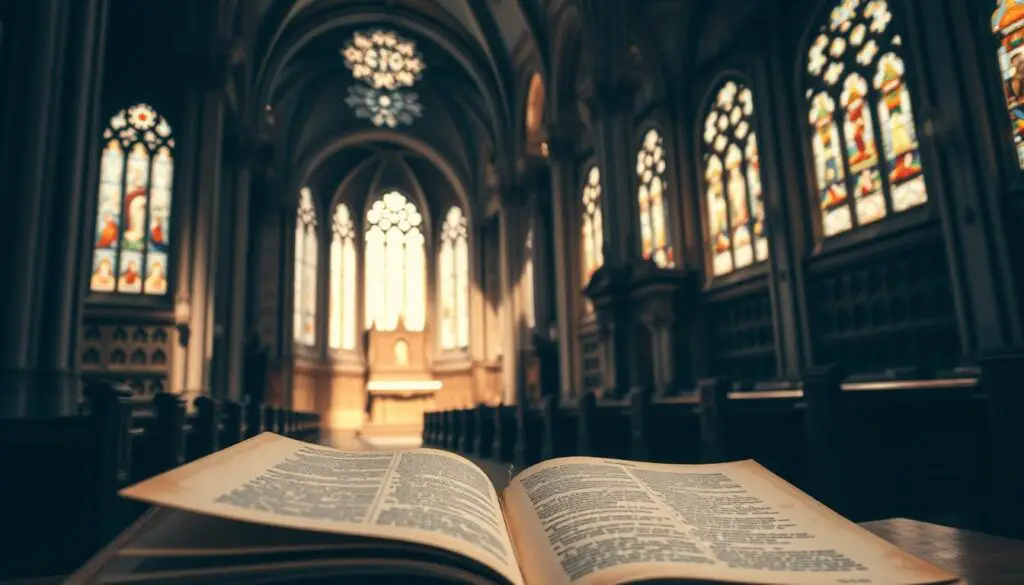As winter approaches, few experiences capture the spirit of the season like timeless holiday concerts. For over a century, a renowned musical group from The Church of Jesus Christ of Latter-day Saints has delivered breathtaking performances that blend sacred hymns with festive classics. Their annual celebration transforms historic venues into wonderlands of sound, light, and shared joy.
This cherished event features orchestral arrangements that honor tradition while embracing modern creativity. Beloved carols like “Silent Night” and “Joy to the World” receive fresh interpretations, creating moments that resonate with both longtime fans and first-time listeners. The combination of soaring vocals and intricate instrumentation turns every song into a memorable experience.
Beyond the music, these gatherings create a unique sense of community. Imagine standing in a beautifully decorated square, surrounded by thousands united in song. This tradition continues to evolve through streaming releases, making its magic accessible to global audiences. Later sections will explore how to experience these performances and their cultural impact.
Key Takeaways
- Historic musical group celebrates the season with signature concerts
- Mix of traditional hymns and innovative arrangements appeals to all ages
- Iconic holiday classics receive fresh, emotional interpretations
- Live events create unforgettable communal experiences
- Modern streaming options expand access to timeless performances
The Holiday Spectacle at Temple Square
For generations, families have gathered at this historic Utah landmark to celebrate the season through song and light. Temple Square becomes a living storybook each December, with over a million twinkling lights framing its granite spires. The air buzzes with anticipation as visitors explore pathways lined with nativity displays and fragrant evergreens.
Where History Meets Holiday Magic
Since 1875, these grounds have hosted celebrations that blend sacred traditions with community joy. The square’s acoustic marvels, like the domed Tabernacle, amplify every carol and orchestra note. Evening performances glow brighter against frost-kissed windows and snow-dusted statues.
Architecture That Sings
Three iconic locations create unique experiences:
| Location | Features | Best For |
|---|---|---|
| Assembly Hall | Victorian-era woodwork | Intimate quartets |
| Conference Center | 21,000-seat auditorium | Grand productions |
| Outdoor Gardens | Interactive light shows | Family photos |
New this year: a synchronized light display set to classic carols. Volunteers hand-place 600 poinsettias around reflection pools, while a 40-foot spruce towers over the plaza. Whether you prefer candlelit hymns or upbeat brass ensembles, the square christmas spirit welcomes all.
Inside the mormon tabernacle choir christmas Experience
The heart of the season shines brightest when voices unite under vaulted ceilings. Each December, a legendary musical tradition transforms Salt Lake City’s Conference Center into a sensory feast.  Over three nights, artists blend time-honored carols with innovative staging, creating moments that linger long after the final note.
Over three nights, artists blend time-honored carols with innovative staging, creating moments that linger long after the final note.
Star-Studded Collaborations
Broadway’s Michael Maliakel brings theatrical flair to classic arrangements, while Downton Abbey’s Lesley Nicol adds warmth through spoken-word storytelling. Past attendees recall guest artists’ ability to bridge generations – one moment highlighting a 19th-century hymn, the next introducing a global percussion ensemble.
Securing Your Seat
Free tickets for the 2024 concerts (Dec 19-21) become available October 1 via online lottery. Demand always exceeds supply, but hopefuls can join standby lines 90 minutes before shows. Key details:
| Date | Special Feature | Broadcast Partner |
|---|---|---|
| Dec 19 | Orchestral overture | BYUtv (live) |
| Dec 20 | Youth choir showcase | PBS (primetime) |
| Dec 21 | Encore performance | Streaming platforms |
Doors open 90 minutes early for exploring lobby displays about the event’s 50-year history. From the first harp glissando to the last snowflake projection, every detail celebrates music’s power to connect communities.
Embracing the Musical Legacy and Festive Media
The harmony of tradition and innovation extends far beyond live performances. For decades, seasonal celebrations have been preserved through carefully crafted recordings and broadcasts, allowing fans worldwide to relive magical moments year after year.
Albums, DVDs, and the Streaming Revolution
The 2022 holiday concert album broke streaming records with over 500,000 plays in its first week. Physical collectors can order limited-edition CDs and DVDs bundled with The Light That Shines Forever – a 120-page book detailing behind-the-scenes stories. Three formats keep the legacy alive:
- Digital downloads for instant access
- Collector’s box sets with archival photos
- Interactive streaming editions with commentary tracks
PBS, BYUtv Partnerships, and Special Broadcasts
For 47 years, public television has brought these performances to living rooms nationwide. Last December’s primetime special drew 4.2 million viewers – the highest ratings since 2018. Key partnerships deliver unique experiences:
| Network | Special Features | Air Dates |
|---|---|---|
| PBS | Behind-the-scenes documentary | Dec 15-25 |
| BYUtv | Multi-camera live streams | Dec 19-21 |
Traditional Carols and Modern Twists
Arrangers blend centuries-old melodies with fresh instrumentation. A recent rendition of “O Come, All Ye Faithful” featured a jazz saxophone solo over the choir’s signature harmonies. This creative approach keeps classic carols feeling new while honoring their roots.
Over 150 production team members work year-round to balance nostalgia with innovation. From lighting designers to sound engineers, their collaboration ensures each concert becomes a timeless treasure. As technology evolves, so does the art of sharing holiday cheer through music.
Conclusion
The power of shared music continues to define this beloved seasonal tradition. From soaring vocal harmonies in historic venues to modern streaming releases, these Christmas concerts create connections across generations. Guest artists add fresh energy to time-tested carols, while the free ticket lottery system keeps access equitable for all.
For those who can’t attend live, the choir temple legacy lives through recordings. New album releases and collector’s DVD sets make perfect holiday gifts, preserving orchestral magic year-round. Fans especially cherish limited editions featuring behind-the-scenes stories.
Don’t miss future updates – join the email list for first access to ticket alerts and exclusive content. Whether you stream the latest Christmas concerts or revisit classic album tracks, these performances remind us how music unites communities.
Gather your loved ones this season. Experience the glow of live performances or cozy up with timeless recordings. However you choose to engage, let these melodies become part of your family’s story.
FAQ
What makes the holiday event at Temple Square unique?
The celebration combines decades-old traditions with breathtaking venues like the Conference Center. Thousands of twinkling lights, festive decor, and live music create an unforgettable atmosphere.
Can I attend performances at other venues besides the Conference Center?
Yes! Events often occur across Temple Square, including the Tabernacle and Assembly Hall. Each location offers distinct acoustics and historic charm during the season.
Are guest artists part of the Christmas concerts?
Absolutely! Renowned vocalists, instrumentalists, and storytellers frequently collaborate with the ensemble. Past performers have included Broadway stars and Grammy-winning musicians.
How can I secure tickets for the holiday performances?
Free tickets are typically released online each fall. Sign up for email updates through the official website for exact dates and reservation details.
Are recordings of past concerts available for purchase?
Yes! Iconic performances are released as albums and DVDs. Many tracks also stream on popular platforms, letting you enjoy the music year-round.
Where can I watch broadcasts of the events?
Tune into PBS stations nationwide or BYUtv for annual specials. These partnerships bring the magic of the concerts to millions of homes globally.
Does the music blend classic and contemporary styles?
Definitely! Listeners enjoy traditional carols alongside fresh arrangements. This mix honors heritage while appealing to modern audiences.







